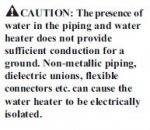Strathead
Senior Member
- Location
- Ocala, Florida, USA
- Occupation
- Electrician/Estimator/Project Manager/Superintendent
JWElectric, you are just being stubborn. First by trying to interject that the code is clear and no one should have any questions, and then to state as fact your answers to all of the questions that other, known, highly competent, posters on this site raise!
If the code was clear we wouldn't have 14 pages on this discussion. For you and one other question, I am the one that raised the question of maintaining electrical continuity of the "metallic water system (s)" Since the code doesn't define a metallic water system, I raised the question of whether each contiguous section of metallic pipe needed to comply with 250.104 (A). Through various posts, especially yours showing the code board opinion, I now see that this was not the intent of the code in their minds. But, since this is not in the code, it is not clear to the average electrician, or inspector without major research.
No matter how much you present your opinions as fact, it doesnpt clarify or especially justify this code section. In a nut shell, if there are numerous sections of metal piping throughout a sturcture, all isolated from each other with nonmetallic sections of piping, which section would one decide was THE "metallic water system" you contend needs to comply with this code section? Unless you are insisting on being stubborn with no desire to actually be helpful here (I absolutely don't believe you don't desire to be helpful), you can see that there can not be only one answer to this question unless all of the various parts are made electrically continuous and that does not appear to be the intent of this code section.
In conlusion, this code section stinks and it doesn't make sense with today's construction standards. In my opinion there is no safety value in bonding any metal portion of a building's water piping with a 250.66 size grounding conductor. A 250.122 size grounding conductor to comly with 250.104(B) would satisfy any safety concerns for any and all sections of water pipe. The only marginal argument there could be for a 250.66 conductor would be when the water pipe is designated a grounding electrode, but I think this is an error, because nothing in the various plumbing codes prevents a plumber from converting the underground metal piping to plastic.
If the code was clear we wouldn't have 14 pages on this discussion. For you and one other question, I am the one that raised the question of maintaining electrical continuity of the "metallic water system (s)" Since the code doesn't define a metallic water system, I raised the question of whether each contiguous section of metallic pipe needed to comply with 250.104 (A). Through various posts, especially yours showing the code board opinion, I now see that this was not the intent of the code in their minds. But, since this is not in the code, it is not clear to the average electrician, or inspector without major research.
No matter how much you present your opinions as fact, it doesnpt clarify or especially justify this code section. In a nut shell, if there are numerous sections of metal piping throughout a sturcture, all isolated from each other with nonmetallic sections of piping, which section would one decide was THE "metallic water system" you contend needs to comply with this code section? Unless you are insisting on being stubborn with no desire to actually be helpful here (I absolutely don't believe you don't desire to be helpful), you can see that there can not be only one answer to this question unless all of the various parts are made electrically continuous and that does not appear to be the intent of this code section.
In conlusion, this code section stinks and it doesn't make sense with today's construction standards. In my opinion there is no safety value in bonding any metal portion of a building's water piping with a 250.66 size grounding conductor. A 250.122 size grounding conductor to comly with 250.104(B) would satisfy any safety concerns for any and all sections of water pipe. The only marginal argument there could be for a 250.66 conductor would be when the water pipe is designated a grounding electrode, but I think this is an error, because nothing in the various plumbing codes prevents a plumber from converting the underground metal piping to plastic.


